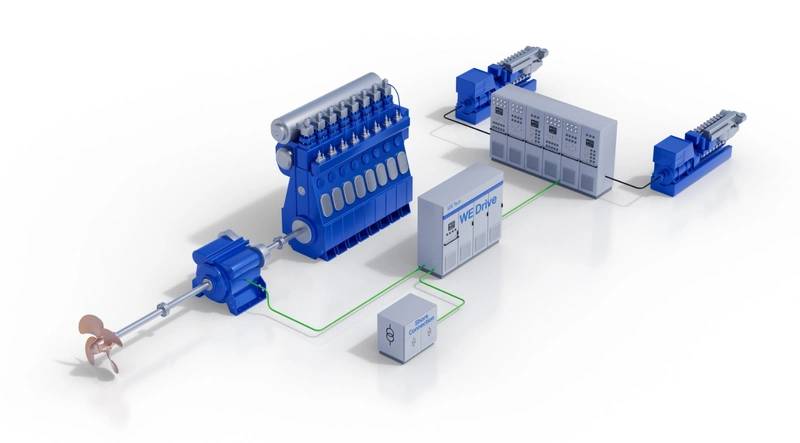Goltens, WE Tech Partner Up on Energy-Efficient Marine Retrofits – Marine Link

Strategic Partnership to Advance Sustainable Development Goals in the Maritime Sector
Introduction and Alignment with Global Goals
A Memorandum of Understanding (MOU) has been established between Goltens Worldwide and WE Tech Solutions to facilitate advanced marine retrofit projects. This collaboration is strategically designed to enhance vessel energy efficiency and reduce emissions, directly contributing to the United Nations Sustainable Development Goals (SDGs).
- The partnership leverages complementary expertise to accelerate the maritime industry’s transition towards sustainability.
- It aims to provide shipowners with a clear pathway to modernize fleets in alignment with international environmental regulations and global sustainability targets.
Contribution to Specific Sustainable Development Goals (SDGs)
The initiative is directly aligned with several key SDGs, demonstrating a commitment to global sustainable development:
- SDG 7 (Affordable and Clean Energy): By promoting the adoption of energy-efficient technologies, the partnership works to reduce the energy intensity of the global shipping fleet, a key target under SDG 7.
- SDG 9 (Industry, Innovation, and Infrastructure): The collaboration focuses on upgrading maritime infrastructure with clean and environmentally sound technologies, fostering innovation for a sustainable industrial future.
- SDG 13 (Climate Action): The primary objective is to cut emissions and support decarbonization, directly addressing the urgent need for climate action by mitigating the maritime sector’s environmental impact.
- SDG 17 (Partnerships for the Goals): This MOU exemplifies a strategic global partnership, combining technological innovation with worldwide implementation capabilities to achieve shared sustainability objectives.
Roles and Responsibilities in a Partnership for the Goals (SDG 17)
The partnership structure is designed to maximize impact through specialized contributions:
- WE Tech Solutions: As the technology provider, WE Tech will supply its field-proven energy-optimization solutions, including:
- Variable-frequency drive and permanent-magnet shaft-generator systems
- DC-Link power-distribution architecture
- Advanced power-management systems
- Goltens Worldwide: As the preferred global retrofit partner, Goltens will provide comprehensive execution and lifecycle support through its global service network, including:
- Engineering and 3D scanning
- Installation and commissioning
- Ongoing lifecycle support
Targeted Impact on Climate Action and Sustainable Industry (SDG 13 & SDG 9)
The collaboration targets significant environmental and economic improvements across a diverse range of vessel types, including ferries, tankers, Ro-Ro ships, and bulk carriers. The intended outcomes directly support climate and industry-related SDGs by:
- Improving electrical performance to significantly reduce fuel consumption.
- Cutting emissions to meet and exceed the decarbonization goals set by the International Maritime Organization (IMO).
- Accelerating the global uptake of advanced electrification and energy-optimization retrofits for a more sustainable and resilient shipping industry.
Analysis of Sustainable Development Goals (SDGs) in the Article
1. Which SDGs are addressed or connected to the issues highlighted in the article?
-
SDG 7: Affordable and Clean Energy
- The article focuses on a partnership to deliver projects “aimed at improving vessel energy efficiency.” This directly supports the goal of ensuring access to affordable, reliable, sustainable, and modern energy for all, particularly through efficiency improvements.
-
SDG 9: Industry, Innovation, and Infrastructure
- The collaboration is centered on promoting and delivering “advanced marine retrofit projects” and “energy-optimization technologies.” This aligns with building resilient infrastructure, promoting inclusive and sustainable industrialization, and fostering innovation by upgrading the shipping industry’s infrastructure to be more sustainable and efficient.
-
SDG 13: Climate Action
- A primary objective of the partnership is “cutting emissions” and supporting customers on their “decarbonization journey.” This directly addresses the urgent need to combat climate change and its impacts, especially in line with the mentioned “International Maritime Organization decarbonization goals.”
-
SDG 14: Life Below Water
- By aiming to reduce emissions from the commercial shipping fleet, the initiative helps mitigate the impact of maritime activities on marine ecosystems. Reducing CO2 emissions, a key goal, contributes to minimizing ocean acidification, which is a significant threat to marine life.
-
SDG 17: Partnerships for the Goals
- The article is fundamentally about a partnership, evidenced by the “memorandum of understanding (MOU)” between Goltens Worldwide and WE Tech Solutions. This collaboration between two companies to achieve common sustainability goals exemplifies the spirit of strengthening the means of implementation and revitalizing the global partnership for sustainable development.
2. What specific targets under those SDGs can be identified based on the article’s content?
-
Target 7.3: By 2030, double the global rate of improvement in energy efficiency.
- The article explicitly states that the partnership’s goal is to promote and deliver projects “aimed at improving vessel energy efficiency” and that WE Tech’s technology is “energy-efficient.” The entire initiative is built around retrofitting ships to “reduce fuel consumption,” which is a direct measure of improved energy efficiency.
-
Target 9.4: By 2030, upgrade infrastructure and retrofit industries to make them sustainable, with increased resource-use efficiency and greater adoption of clean and environmentally sound technologies and industrial processes.
- The agreement focuses on being a “global retrofit partner” to roll out “energy-optimization technologies.” The text mentions specific technologies like “variable-frequency drive and permanent-magnet shaft-generator systems” and describes the work as “advanced electrification and energy-optimization retrofits,” which directly corresponds to upgrading and retrofitting an industry for sustainability.
-
Target 13.2: Integrate climate change measures into national policies, strategies and planning.
- The collaboration’s aim to cut emissions is explicitly “in line with International Maritime Organization decarbonization goals.” This shows the integration of international climate change strategies (set by the IMO) into corporate and industry-level planning and action.
-
Target 17.17: Encourage and promote effective public, public-private and civil society partnerships, building on the experience and resourcing strategies of partnerships.
- The MOU between Goltens Worldwide and WE Tech Solutions is a clear example of a private-private partnership formed to achieve sustainable development objectives. The article highlights how they combine their respective strengths—”WE Tech’s technology” and “Goltens’ delivery expertise”—to “accelerate the uptake” of sustainable solutions.
3. Are there any indicators mentioned or implied in the article that can be used to measure progress towards the identified targets?
-
Implied Indicator for Target 7.3: Reduction in fuel consumption.
- The article repeatedly states the goal is to “reduce fuel consumption” and “cut fuel costs.” This serves as a direct, measurable indicator of progress in energy efficiency (related to official indicator 7.3.1: Energy intensity). A lower amount of fuel used to travel the same distance or transport the same cargo indicates improved efficiency.
-
Implied Indicator for Targets 9.4 and 13.2: Reduction in emissions.
- The commitment to “cutting emissions” and supporting “decarbonization” is a central theme. The amount of greenhouse gas emissions reduced per vessel or across the fleet after the retrofits would be a key performance indicator, aligning with the intent of official indicator 9.4.1 (CO2 emission per unit of value added).
-
Implied Indicator for Target 17.17: Number of vessels retrofitted through the partnership.
- The success of the partnership can be measured by the “rollout of the Finnish company’s energy-optimization technologies across the commercial shipping fleet.” The number of “large-scale retrofit execution” projects completed on vessels like “ferries, tankers, Ro-Ro ships and bulk carriers” would be a tangible indicator of the partnership’s effectiveness.
4. Table of SDGs, Targets, and Indicators
| SDGs | Targets | Indicators |
|---|---|---|
| SDG 7: Affordable and Clean Energy | 7.3: By 2030, double the global rate of improvement in energy efficiency. | Reduced fuel consumption and improved vessel energy efficiency. |
| SDG 9: Industry, Innovation and Infrastructure | 9.4: By 2030, upgrade infrastructure and retrofit industries to make them sustainable, with increased resource-use efficiency and greater adoption of clean and environmentally sound technologies. | Number of vessels undergoing “advanced marine retrofit projects” with “energy-optimization technologies.” |
| SDG 13: Climate Action | 13.2: Integrate climate change measures into national policies, strategies and planning. | Reduction in emissions in line with “International Maritime Organization decarbonization goals.” |
| SDG 17: Partnerships for the Goals | 17.17: Encourage and promote effective public, public-private and civil society partnerships. | The formation of the MOU and the number of joint retrofit projects executed. |
Source: marinelink.com
What is Your Reaction?
 Like
0
Like
0
 Dislike
0
Dislike
0
 Love
0
Love
0
 Funny
0
Funny
0
 Angry
0
Angry
0
 Sad
0
Sad
0
 Wow
0
Wow
0
















































/environment-climate-change-and-health-(ech)/water-sanitation-hygiene-and-health-(wsh)/landfill-tuvalu-36092.tmb-1200v.jpg?sfvrsn=5c21fe40_1#)

.jpg.webp?itok=0ZsAnae9#)


























